SAU 10.5 cm leFH18 / 3 (Sf) auf Geschützwagen B2 (f). French tank and German howitzer
Before the end of hostilities, the French industry managed to build a little more than 400 heavy infantry tanks B1 of three modifications. In the battles, no more than 350 machines were used, about two hundred of which were destroyed. According to the results of the war, the 161 heavy tank made in France was at the disposal of the German troops. Replacing the owner, the tanks received a new designation Pz.Kpfw B2 740 (f). In addition, as far as possible, they were subjected to small upgrades. In particular, outdated radio stations were replaced. Also, an idea about the conversion of the captured tanks into the technology of new classes soon appeared.
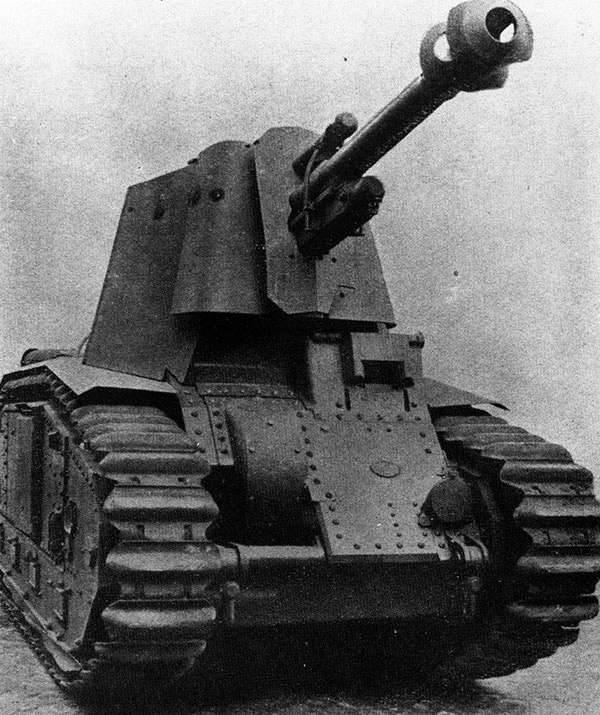
General view of ACS 105 leFH18B2. Photo Warspot.ru
By replacing those or other components of the machine B1 proposed to turn into a self-propelled artillery or flamethrower tanks. In addition, a simplified version of the modernization was envisaged, the purpose of which was to manufacture tractor units devoid of towers and armaments. The decision to start the development of an ACS based on a heavy tank was made in the spring of 1941. March 28 The 4 Department of the Army Armaments Department, responsible for the development of artillery, issued to Rheinmetall-Borsig an order and technical task for the development of a new self-propelled gun.
In accordance with the order of the 4 department, the contractor company had to develop a new combat vehicle based on the Pz.Kpfw B2 740 (f) tank. From the base tank it was necessary to dismantle all the existing weapons, instead of which it was necessary to install a wheelhouse with the 105-mm field howitzer leFH18. The project received the difficult name, traditional for the German nomenclature, reflecting all basic elements of the car: 10.5 cm leFH18 / 3 (Sf) auf Geschützwagen B2 (f). The abbreviation 105 leFH18B2 was also used, also showing how the machine was made. The first order of the military meant making 16 new SAU.
Tank Char B1 had a distinctive appearance, but from the point of view of the main features of the design, it did not differ much from similar armored vehicles of that time. For example, the corps was built according to the classical layout and had a front control compartment with a part of weapons, a central combat compartment with a turret and a engine compartment in the stern. The body was assembled from sheets with thickness from 20 (bottom) to 60 (forehead) mm with the help of bolts and rivets. It should be noted that it was the relatively thick armor and a high level of protection that interested the Germans and contributed to the continued operation of the captured technology.
In the aft part of the hull of B1 tanks of various modifications, the Renault gasoline engine with 250 or 307 hp was installed. Used hydraulic transmission company Naeder with a five-speed gearbox. The tank received an original chassis with a caterpillar covering the hull. As part of the chassis used 14 road wheels on each side. The rollers were interlocked in carts with elastic suspension elements.
Tank B1 had an unusual by modern standards composition of weapons. The main weapons The machine was a 75-mm gun mounted in the embrasure of the frontal part of the hull. An extra 47-mm gun was placed in a rotating turret. There were also two rifle caliber machine guns. It was assumed that with the help of machine guns the crew would be able to attack the enemy's manpower, the tower gun would be used to attack enemy tanks, and the 75-mm gun would become a means for destroying field fortifications.
The combat mass of the French tank model B1-bis was 32 tons. The car was driven by a crew of four. Applied 307-strong engine allowed to reach speeds up to 28 km / h. Power reserve was determined at the level of 150 km.
Specialists of the company "Rheinmetall-Borzig" got a relatively good base for promising armored vehicles. The trophy tank had both positive and negative features, but with the right approach it could easily be used as a base for self-propelled artillery guns. To obtain the best possible result, it was decided to leave most of the units of the existing tank unchanged. At the same time, the new 105 leFH18B2 project involved dismantling one equipment and installing another.
In accordance with the new project, the B1 tank was to lose the turret and the guns in the front hull plate. Removing the 75-mm guns led to the release of the front embrasure, forcing the engineers to take appropriate measures. On the curved frontal armor element installed armor plate of the appropriate form. This alteration led to the release of significant volumes in the department of management, which could be taken by new equipment or part of the ammunition.
From the tank was proposed to remove the tower with weapons and sighting devices. Instead of a tower on a podbashnoy box, it was planned to mount a polygonal wheelhouse of complex shape. In the construction of the felling should be used armor plates with a thickness of 20 mm. The sheets had a different shape and size and were installed with a slope inward. The finished cabin had diverging sides of the sides and converging rear ones. The roof was not provided.
In front of the cabin, on the roof of the base tank, mounted cabinet for mounting gun mounting systems. The attachment systems of the implement allowed horizontal guidance in a sector of width 30 ° and set elevation angles from -5 ° to + 20 °.
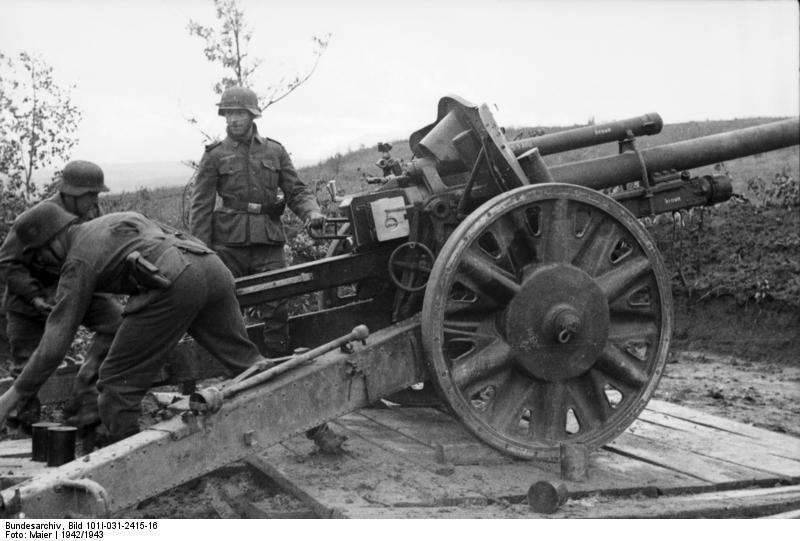
Howitzer leFH18 at the front. Photo of Wikimedia Commons
The 105-mm light field howitzer mod. 1918 d. 10,5 cm leFH18. This gun had a barrel length 25 gauges (2,6 m) and was equipped with a horizontal sliding gate. In addition to the muzzle brake, a hydropneumatic recoil device was used to reduce the recoil momentum. The howitzer had a separate-sleeve loading and could perform up to 4-6 shots per minute. The initial velocity of the projectile reached 470 m / s. In the basic configuration, the gun was mounted on a carriage with sliding beds and wheel travel. Also provided for armor shield.
When creating a new self-propelled gun, the leFH18 howitzer together with the recoil devices and some other units were installed on the pedestal inside the new wheelhouse. In order to further reduce the recoil momentum and reduce the load on the body, the gun was equipped with a new muzzle brake. For a certain simplification of the structure of the cabin in its front sheet provided for a vertical slot to move the barrel of the howitzer. The front slot was covered with a relatively narrow armor shield-mask mounted on the gun. Regardless of the position of the barrel, the mask covered the cabin cut and protected the crew from bullets or debris.
For shooting at visible targets, it was proposed to use the ZE34 telescopic sight. In closed positions, a panorama like Rblf-36 should be used. When hovering used hand drives.
Due to the release of space inside the hull, associated with the dismantling of the original equipment and weapons, ammunition from 42 separate loading shells was placed inside the crew compartment and the cabin.
In addition to modifications of the hull and installation of new weapons, the project involved the use of new communication equipment. Instead of outdated French-made radio stations, some of which allowed messages to be transmitted only by Morse code, the 10.5 ACS cm leFH18 / 3 (Sf) auf Geschützwagen B2 (f) should receive modern FuG5 systems that provide full voice communication.
Despite all the changes, the size and weight of the combat vehicle remained at the same level. So, the length of the ACS remained at the level of 6,5 m, the width did not exceed 2,5 m. The height of the machine increased by several decimeters and passed through the mark of 3 m. Due to the dismantling of the old weapons and the tower with the subsequent installation of the wheelhouse and howitzer, the combat weight of the machine increased to 32,5 t .
The technical task for the development of the new ACS 105 leFH18B2 was received at the end of March 1941. A few months later, Rheinmetall-Borsig engineers completed the development of the project and began preparations for the construction of a prototype machine. At this stage they had to suspend work for some time. The fact is that all captured heavy tanks of French production were transferred to 6-th department of arms control, engaged in tanks. The equipment was sent for repair, which led to some delay in the work on the new project.
In late spring, Rheinmetall-Borzig still received a B1-bis tank for the construction of an experimental self-propelled gun. From the provided armored vehicles they removed the available weapons and dismantled the turret. On the vacant seats installed new units. In view of the experienced purpose of the vehicle, the first prototype did not receive new armor plates. The wheelhouse and plug of the front embrasure were made of ordinary structural steel with the required strength and weight parameters.
The first prototype self-propelled gun 10.5 cm leFH18 / 3 (Sf) auf Geschützwagen B2 (f) came to the test in June 1941 year. The next few weeks, the car overcame various obstacles at the site, and also fired at training targets. In the course of brief trials, all the positive and negative aspects of the project were identified, as well as the refinement and correction of some shortcomings.
The preservation of the French engine and a slight increase in combat mass led to the fact that the mobility of the self-propelled gun remained at the level of the base tank. The speed on the highway did not rise above 28 km / h, and the cruising range did not exceed 150 km. In some cases, the problem could be a slight increase in the height of the car, but this was not considered a serious disadvantage. In general, the promising self-propelled gun met the requirements and could be used in the army.
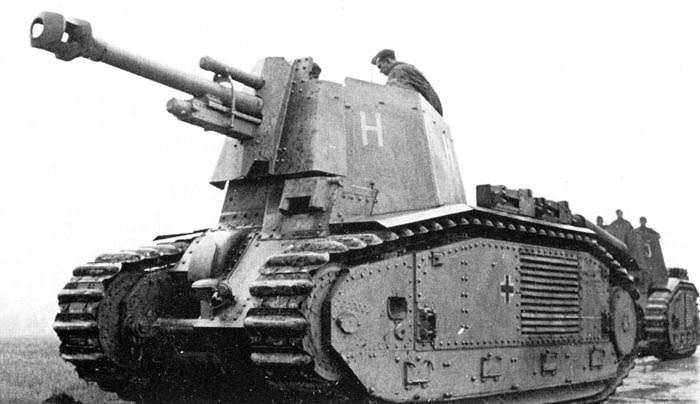
One of the samples of the combat vehicle. Photo Panzerw.narod.ru
According to the test results, the 4 department allowed to start the serial construction of new equipment. In accordance with the plan that appeared soon, before the end of 1941, the contracting company had to build and deliver to the customer two lots of five self-propelled guns (including a prototype), and on 42, they planned to hand over six more cars. At this stage, the industry again had to face a shortage of equipment. Only by the end of the year, the first trophy chassis, which were repaired, arrived at the production, after which it became possible to assemble the first serial 105 leFH18B2.
Nevertheless, despite all the problems, soon all the necessary equipment arrived at the Rheinmetall-Borsig plant. From the end of 1941 to March 1942, the company collected all the ordered self-propelled guns. The troops were handed 15 machines (according to other sources, all 16, including the experienced one). The rapid implementation of the order, among other things, contributed to the minimum number of changes made to the design of the base armored vehicle.
New artillery self-propelled guns initially decided to send to the defense of the northern coast of occupied Belgium. All 15 serial machines 10.5 cm leFH18 / 3 (Sf) auf Geschützwagen B2 (f) received the 93-th artillery regiment of the 26-th tank division. Three batteries appeared in the regiment, into each of which three self-propelled guns were introduced. The remaining were in reserve. The transfer of equipment took place in the spring of the year 1942, after which the 93-th regiment began its development.
Tests of self-propelled guns showed that after all the improvements, the main characteristics remained at the level of the base tank. However, B1 did not differ in high performance, which accordingly affected the operation of new SAUs. The gunners of the 93 regiment were not satisfied with the low mobility of the machines, as well as their lack of reliability. As it turned out, 105 leFH18B2 has a tendency to frequent breakdowns, which hampered the operation of a few vehicles.
Because of these problems, over time, it was decided to abandon the operation of existing self-propelled guns based on a French tank. Subsequently, the 93 artillery regiment received self-propelled guns of the Wespe type, distinguished by higher characteristics and greater reliability. 105 leFH18B2, in turn, was sent to one of the training units for use in the training of driver-mechanics and artillerymen. Interestingly, only 15 went from 14 machines to the training center. Another self-propelled gun during operation received serious damage and could not be recovered.
ACS based on the B1 tank were used as training machines until the middle of the 1944 year. Information about the future of this technique vary. According to some data, self-propelled guns took part in the battles in Normandy, according to others, were transferred to the south of Europe. It should be noted that the second version has more details and therefore looks more realistic.
According to available information, at the end of the summer or early autumn 1944, all the existing 10.5 cm leFH18 / 3 (Sf) auf Geschützwagen B2 (f) went to serve in the 90 9th tank-grenadier division, which at that time was preparing to defend on. Sardinia. In connection with the onset of the anti-Hitler coalition, in the middle of September the 90 Division redeployed several times: first it was taken from Sardinia to Corsica, and then sent to the mainland. Has the division managed to get a half dozen self-propelled guns by this time is unknown. Accurate information about the use of this technology in the battles and its future fate is not available.
At the beginning of 1942, 16 105 leFH18B2 self-propelled guns were built at Rheinmetall-Borsig, including one prototype without a full reservation. Soon, this technique was transferred to the troops, who used it, at least until the autumn of 44. What exactly happened to the self-propelled guns in the future is unknown, but this technique did not live to our time. All collected copies were either destroyed in battles, or went to the smelter at one or another stage of the service.
During World War II, Nazi Germany showed a very interesting approach to the disposal of captured equipment. The vehicles recaptured from the enemy were repaired and operated by their own troops. In addition, some cars were modernized, including with the transition to another class and a change in tactical role. One example of such an approach to captured vehicles was the project for the construction of self-propelled guns based on the French Char B1 tank and the German leFH18 howitzer. These machines do not have any special achievements, but they are of great interest with historical and technical point of view.
On the materials of the sites:
http://all-tanks.ru/
http://warspot.ru/
http://axishistory.com/
http://ww2history.ru/
http://panzerw.narod.ru/
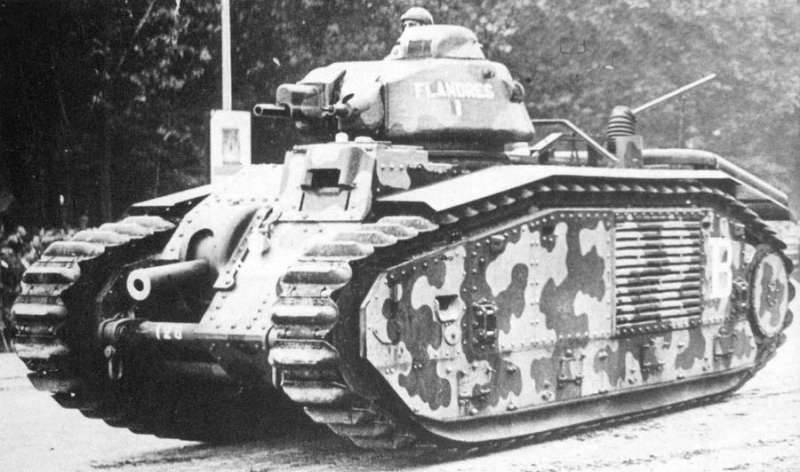
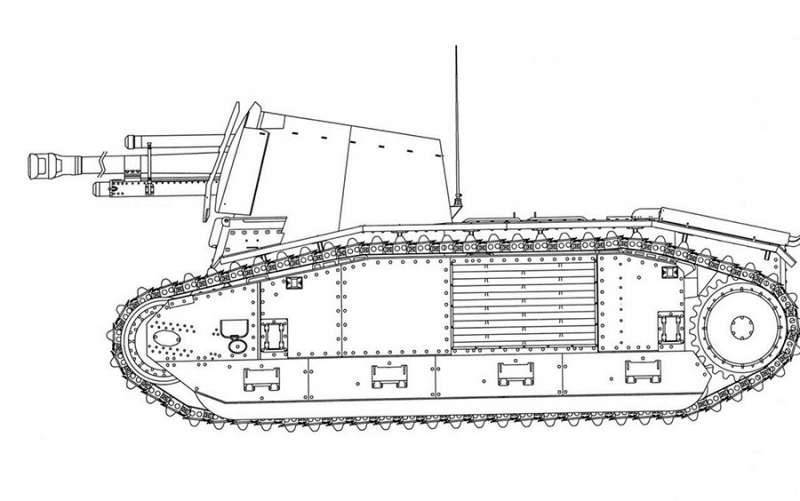
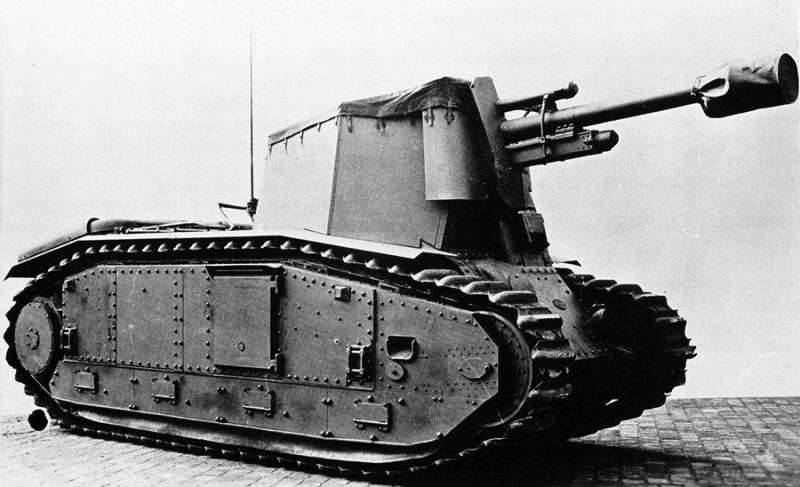
Information